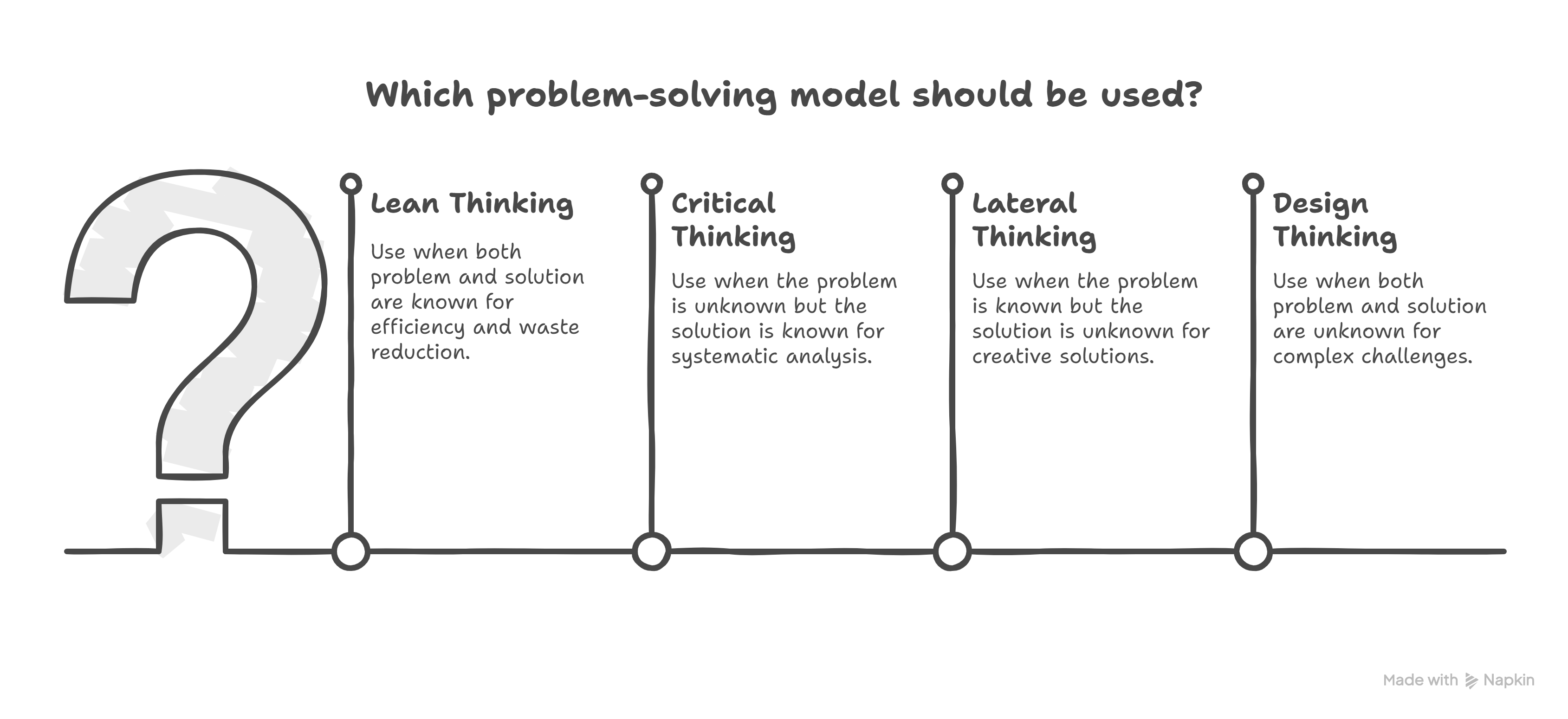The Sweet Spot of Design Thinking
Design thinking isn't the only or best problem-solving model; it is particularly suited for a specific kind of problem. To understand its unique strengths, one must first recognize the limitations of other traditional models. The appropriate problem-solving approach depends on the nature of the problem and the solution, which can be categorized using a two-by-two matrix with "Known" and "Unknown" problems on one axis and "Known" and "Unknown" solutions on the other.
Problem-Solving Models
1. Lean Thinking Lean thinking is a problem-solving approach used when both the problem and the solution are known. This method focuses on efficiency, speed, and waste reduction.
- Problem: The root cause is understood, and the solution is a part of a known set of actions. An example is a parking shortage in an apartment complex where more cars exist than there are parking spots.
- Solution: Lean thinking includes techniques like Six Sigma, Agile, and Scrum, which are used to hasten the speed of processes.
- Example: ATMs are a classic example of lean thinking. The problem (customer wants cash) and the solution (dispensing accurate cash) are both known, making the process easily automated.
2. Critical Thinking Critical thinking is used when the problem is unknown, but the solution is known. It involves a systematic process of asking questions to get to the root cause of the problem.
- Problem: The manifestation of the problem is visible, but the cause is not. For example, why people don't use public transport is an unknown problem, as the reasons vary.
- Solution: The solution involves deploying known methods to analyze the problem, such as the Japanese "5 Whys" analysis and Ishikawa diagrams.
- Example: A doctor uses critical thinking to diagnose a patient's illness. They ask questions about medical history and run tests to understand the unknown problem (the illness) before prescribing a known solution (medication).
3. Lateral Thinking Lateral thinking is a problem-solving approach used when the problem is known, but the solution is unknown. It involves looking at a problem from a different, often unconventional, perspective.
- Problem: The problem is clearly defined, but a solution is not readily apparent. For example, how to place a heavy machine in a pit without a crane.
- Solution: Lateral thinking requires stepping outside of conventional thought patterns.
- Example: At a Maruti Suzuki factory, a heavy machine needed to be placed in a pit without a crane. The solution was to cover the pit with ice, slide the machine on top, and allow the ice to melt overnight, gently lowering the machine into place. This is an example of a resource-constrained situation leading to a creative, lateral solution.
4. Design Thinking Design thinking is the most complex of these models and is used when both the problem and the solution are unknown. It is designed for "wicked problems" that are highly complex and ambiguous, where existing solutions are not sufficient.
- Problem: The problem is multifaceted and the root cause is not immediately clear. For example, why people don't use stairs.
- Solution: Design thinking requires a high level of discovery and empathy to uncover a new solution.
- Example: To encourage people to use stairs instead of escalators in a subway, a design thinking approach was used. The stairs were turned into a giant piano, with each step playing a musical note. This playful and engaging solution, never tried before, successfully nudged people into using the stairs.
The Sweet Spot
Design thinking's sweet spot is in the upper right quadrant of the problem/solution matrix—when faced with an unknown problem and an unknown solution. It is a sledgehammer for tackling highly complex challenges.
While design thinking is powerful for these "wicked problems," it is not a replacement for other models. A skilled problem-solver should be proficient in all methods—lean, critical, lateral, and design thinking—to address the full spectrum of challenges effectively.


No Comments